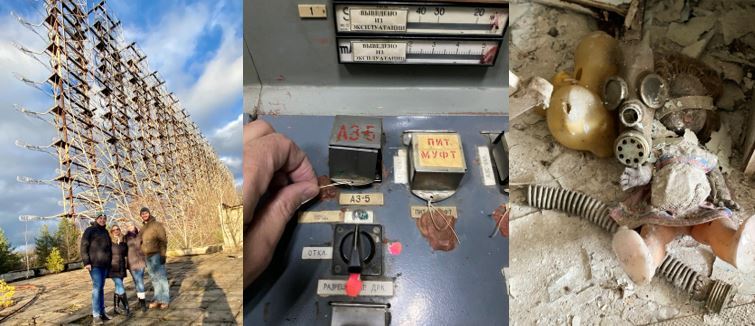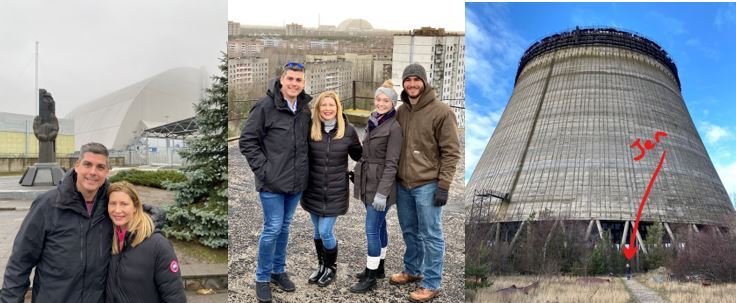Touring Chernobyl Through a Roofer’s Eyes

By Lauren White, RCS Reporter.
A nuclear disaster turns Soviet Union utopia into a ghost town in just a matter of days.
Getting to see the world through a roofer’s eyes is pretty special, and takes us to so many amazing places. Ken Kelly, the President of Kelly Roofing, and also a RoofersCoffeeShop® Influencer, took a trip to northern Ukraine, formerly part of the Soviet Union, where he toured Chernobyl and Pripyat.
While in Ukraine, Ken shares, “I was on the roof of an apartment building with a tar and gravel roof that hasn’t been touched since 1986.” Ken and his fiance Jen saw other impressive architecture while they were at the Chernobyl Power Plant, just outside of the town Pripyat.
Now a ghost city, Pripyat was established in 1970 as a “perfect Soviet town.” The workers for the Chernobyl Power Plant, just two miles away, were to be housed in Pripyat. Unlike other areas in the Soviet Union, Pripyat didn’t have lines, waiting, or shortages of food. It was a Soviet utopia.
“Pripyat town center was the crown jewel of the Soviet Union’s future. It was designed to be the perfect city. The average age was 26 and the town had everything young couples would want in a bright future,” Ken explains. “There were three schools. But, since this was a booming town full of young people excited about life, there were five preschools to every one primary school. 1,500 children were born each year.”
Since Pripyat was advertised as the “poster city” for the Soviet Union, it was given as many resources as Moscow, the capital of Russia. Ken recalls, “This grocery store was stocked full, even as the other Soviet Bloc countries were starving. Surrounding villagers would drive hundreds of miles just to see this supermarket because they couldn’t believe something like this existed.”
The grocery store wasn’t the only impressive aspect of Pripyat. According to Ken, “The Soviet Union’s idea was to create the largest power station in the world, one large enough to supply the Soviet Union and most of Europe with.” This became known as the Chernobyl Power Plant. The plan was to have twelve reactors total. There were four reactors built and functioning, with reactor number five almost complete and groundwork ready to begin on number six. Ken shares, “The sheer size of the surrounding area is incredible. Lakes, rivers, channels, roads and power lines were in place to make this a reality.”
On April 26, 1986, the core of Reactor 4 exploded. “...It blew straight up, hit the roof, turned sideways, and then fell back down onto its foundation,” Ken explains. According to the World Nuclear Association, “The resulting steam explosion and fires released at least 5% of the radioactive reactor core into the atmosphere and downwind.” At the time there were 50,000 people living in Pripyat. Five babies were born the night of the disaster. The day after the explosion, everyone living in Pripyat was evacuated in only two hours. They were instructed to pack three day’s worth of clothing, but they never returned home.
“Although the official death count of 31 was released, there is no telling how many hundreds of thousands around the world were affected by this disaster. What humbles me the most is to think of those miners, helicopter pilots, power plant workers, liquidators, healthcare professionals and other volunteers who put their own lives in danger to protect others. Even those who knew they were going to die, did so without hesitation,” Ken notes.
At the time of the disaster, Pirpyat had the highest pregnancy rate in the Soviet Union. An entertainment complex was being built for the children to enjoy and was only days away from opening when the reactor blew. The amusement park has been made famous by the video game “Call of Duty 4,” which features the park and the iconic ferris-wheel. “The paved area of the amusement park was used after the disaster as a wash station for the helicopters delivering sand to the reactor core,” Ken recounts. Radioactive particles from the helicopters washed down the sewer drain, causing the area to have a high reading for radiation.
Ken and Jen were transported around the grounds of the power plant in a 1970’s era Soviet bus. They wore personal radiation detectors and collectors, which told them “the total amount of exposure received throughout the tour,” Ken reveals. “We later found out it’s equal to one transcontinental flight.”
To enter into the contaminated areas of the plant, protective gear was a must. Ken and his fiance wore jackets, hats, masks, and booties. There were also radiation detectors all throughout the exclusion zone to ensure everyone’s safety. They were able to enter into the control room for Reactor #3, which looked identical to the control room for Reactor #4. They saw the red emergency phone that was used by the supervisor the night of the disaster. They also saw the A3-5 switch, which was the “kill switch” for the power plant. “By pressing the button the technicians thought they were shutting down the reactor, when in fact they caused it to explode,” Ken explains. This was due to a faulty design.
On the other side of a wall separating reactor #3 and #4, was one of the highest readings of radiation during the tour. It read at 9.82 micro Sievert per hour (uSv/h), the unit of measure for measuring radiation levels. Ken reveals, “...our flight at altitude registered 0.88uSv/h. We were only in this location for a few minutes for safety reasons obviously.”
Reactor #4 was recently covered with a large dome protective shell, which contains the reactor and “allows work to begin removing debris and dismantling the core,” Ken shares. There’s an active control room still being used as work continues on decommissioning the plant, “protecting the core and storing spent fuel,” Ken clarifies. Robots are being used to start testing and disassembling the damaged reactor. On the tour Ken learned that the “timing is critical as the foundation under the reactor will not last past 2023. Another disaster could occur.”
During construction of the power plant, the Soviets “changed the design of future reactors by switching to cooling towers,” Ken shares. They saw an unfinished cooling tower that was going to be used for reactor #5. Standing in front of the tower, Jen looks miniscule, and the tower was intended to be 100 feet higher. “It’s simply indescribable how large it is,” Ken explains.
Certain areas are still too contaminated to stop and walk around for risk of exposure. Even a bridge that’s half a mile outside of town is still too dangerous. The “Red Forest'' is another area with high radiation levels and it’s illegal to stop at the forest or go into it. It’s called the Red Forest because a cloud of radioactive dust blew over a portion of the forest. “A few days later the trees died and turned to a rust red color. The entire forest was leveled and burned by the liquidators,” Ken discloses. “It was later replanted, but the radiation in this area is very high…”
During the tour, they also saw the Duga Radar Station. This was a “$1.7 billion dollar project to detect a missile launch from the United States,” Ken explains. “The theory, which never actually worked, was that a station hundreds of miles away would send a signal towards space, bounce it off the ionosphere, detect an object halfway around the world and help guide jets towards the missile’s location to destroy it before it landed.” However, it didn’t work like they thought it would. The radar detected everything, including passenger jets. The radar also made a beeping sound that was detectable in nearly every radio communication’s device around the world. “It was later named ‘the woodpecker’ because the West could not place where the interference came from,” Ken explains.
The control room of the Duga Radar Station had a striking resemblance to NASA’s Kennedy Space Center’s Space Shuttle Launch Center control room. “Under the 1 kilometer long Duga radar is a supporting building that protected the cables, components, and equipment to power it. This building is a full kilometer long. Looking down this hall is like looking into two mirrors facing each other; it never ended,” Ken reveals.
With an ideal location, stocked grocery store, and a booming population, Pripyat and the Chernobyl Power Plant had a bright future. Unfortunately, the explosion of Reactor #4 turned a Soviet Union utopia into a ghost town. It remains one of the worst nuclear disasters the world has seen. We are grateful Ken Kelly and his fiance Jen shared their photos and this story with us. We now have a better understanding of the durability of their roofs, their impressive architecture, and the devastation that was caused to this city and the surrounding area.
Interested in more? Sign up for the RCS Week in Review!























Comments
Leave a Reply
Have an account? Login to leave a comment!
Sign In